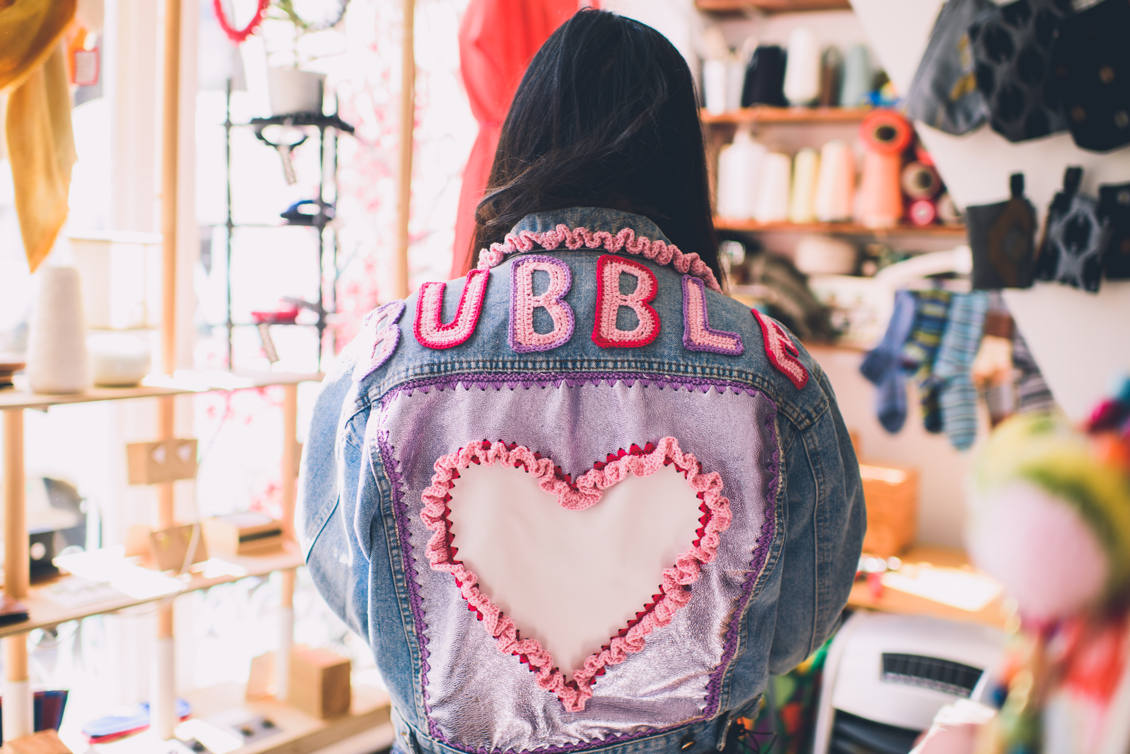Fashion Revolution 2018: Interview with Carry Somers
Getting ready for Fashion Revolution Week 2018? From 23 to 29th April, thousands of events will take place globally -including catwalks, street art and film screenings-, starting with the annual Fashion Question Time in the UK Houses of Parliament. Our exclusive interview with Carry Somers, founder of the Fashion Revolution Movement, show us all you should know about this edition and how your voice can make a difference.
Since Fashion Revolution started, five years ago, people from all over the world have used their voice and their power to tell brands that things must change. And it’s working. Brands are listening and being more open about where their clothes are made. More manufacturers are making their factories safer. More producers are being seen and heard. The movement is getting bigger and bigger. Next week we will witness a new revolution. We managed to catch up with Carry Somers, founder of Fashion Revolution, to find out more about Fashion Revolution 2018 and why she and many others are resolute in calling for change in the fashion industry.
Fashion Revolution Week 2018 is just around the corner. What activities are we going to be able to enjoy in Europe during the next Fashion Revolution Week?
24 April 2018 will be the 5th anniversary of the Rana Plaza factory collapse and five years since Fashion Revolution was born. During that time, millions of people have joined Fashion Revolution to demand a fairer, more transparent industry. Thousands of events will take place globally including catwalks, street art and film screenings, starting with our annual Fashion Question Time in the UK Houses of Parliament.
To mark the anniversary, Fashion Revolution will publish new ground-breaking research into levels of transparency across the 150 biggest global fashion brands and retailers. A worldwide showcasing initiative of interactive Fashion Open Studio events will help open up the conversation about how clothes are made and an inspirational new film will connect a young global fashion-loving audience to fashion producers and makers. Fashion Revolution will also share its positive vision of the future of the industry through launching our Manifesto.
As in previous years, we want people around the world to show their label, post a photograph on social media, tag the brand and ask #whomademyclothes. By doing this, we are applying pressure in the form of a perfectly reasonable question that brands and retailers should be able to answer. We are asking them to publicly acknowledge the people who make our clothes. We want brands, retailers, factories, private and white label manufacturers and all other stakeholders to demonstrate transparency by showing us the people who make our clothes, answering with the hashtag #imadeyourclothes.
Since Fashion Revolution was founded, how has the fashion industry changed? And the consumption of fashion? Can you give us some encouraging figures?
In terms of transparency, we have certainly seen improvements in the fashion industry in the past five years as more brands are understanding the importance of publishing information about their suppliers and their codes of practice, coupled with pressure from consumers and from new legislation such as the Modern Slavery Act and the French Duty of Vigilance Law. We’ve counted 152 brands across 32 parent groups that are disclosing at least some of the facilities making their clothes. For those who want to know more about the Transparency Trends, click here.
Whilst more brands are starting to publish data on their social and environmental efforts, there is still so much information about their practices that remains concealed, particularly when it comes to their tangible impact on the lives of workers and on the environment. In short, many brands are failing to ensure their policies are put into practice.
"Tragedies like Rana Plaza are preventable but they will continue to happen until every stakeholder in the fashion supply chain takes responsibility for their actions and impacts" .
Unfortunately, I can’t provide much in the way of encouraging consumption figures. Although we are seeing a slower rate of growth in retail sales, our prodigal consumption habits are still creating an environmental crisis. Global clothing production has more than doubled since 2000, exceeding 100 billion garments a year in 2014, with the average person buying 60% more clothing and keeps it for about half as long as 15 years ago. The fashion industry was responsible for just over 5% of global carbon emissions in 2015 and this figure is projected to increase by more than 60% to nearly 2.8 billion tons per year by 2030. 142 brands representing 7.5% of the global fashion market have signed the 2020 Circular Fashion System Commitment which sets out four key targets to increase textile recycling.
Overall brands are currently doing very little in this respect which is why we need to educate consumers on the impact of their clothing purchases and ways in which they can fill their wardrobes in a more responsible way through your #haulternative and Love Story challenges. Fashion Revolution produced a sell-out fanzine called Loved Clothes Last and we are just about to run a reprint. This proves there is substantial appetite to explore the issues of mass consumption, clothing and textile waste, recycling and circular fashion. We hope to inspire people around the world learn how to make the clothes they love last for longer.
And there are some signs that consumer behaviour is changing. The WRAP Valuing Our Clothes: the cost of UK fashion report published last year found that the amount of clothing in UK household residual waste has reduced by 50,000 tonnes and 700,000 tonnes CO2 were saved through people changing their clothing care habits.

The power of the Fashion Revolution
Why do you think there are still so many people who do not know the dark side of the fashion industry? Is it a lack of information or is the consumer only thinking about his ego?
Fashion Revolution is now the world’s largest fashion activism campaign. Five years of Fashion Revolution means five years of millions of people using their voices and their power to call for greater transparency. However, many people around the world still don’t think about how their clothes are made, where, and under what conditions.
“It has been estimated that putting as little as 25p onto the cost of a garment made in Bangladesh would provide the producers with a living wage and pay for factories to meet fire and building safety standards”.
There seems to be a widespread belief that clothes produced according to basic ethical standards will have to be significantly more expensive and this can perhaps be a convenient excuse to ignore the provenance of their clothing. It has been estimated that putting as little as 25p onto the cost of a garment made in Bangladesh would provide the producers with a living wage and pay for factories to meet fire and building safety standards. Three quarters of people questioned in a YouGov/Global Poverty Project survey said they would be likely to pay an extra 5% for their clothes if there was a guarantee workers were being paid fairly and working in safe conditions. Brands are currently doing very little across the board to ensure workers are paid fairly, from farm to the factory to the shop floor.
However, another misconception is that if you pay more, the conditions must be better, and again this is not necessarily true. Several of the mass-produced luxury brands produce on exactly the same production lines in Bangladesh as the cheaper fast fashion brands. It may have cost marginally more to produce the garment, but the difference in the retail price is mostly mark-up.
In our Garment Worker Diaries project which interviewed 540 garment workers in Cambodia, India and Bangladesh over the course of last year, 40% of workers had seen a fire in their factory. Every day people are risking their lives to make our clothes. Poverty, human rights abuses, unfair wages, discrimination, environmental degradation, waste and lack of transparency remain endemic within fashion supply chains. We still have a long way to go until everyone who makes our clothes can live and work with dignity, in healthy conditions and without fear of losing their life. This is why we still need a Fashion Revolution and are planning to make this Fashion Revolution Week bigger and bolder than ever before.

Sustainable Luxury
Luxury brands and High-End designers have a very powerful voice. They are a good tool to make the movement stronger. Are they going to participate in any action of the next Fashion Revolution Week? How do you see the evolution of their compromise to your movement?
Fashion Open Studio is a worldwide showcasing initiative of interactive events which takes place during Fashion Revolution Week. For the second time, this international calendar of presentations, talks, openings and workshops will shine a light on innovative emerging designers, established trailblazers and major players who are finding alternative ways of producing fashion that is mindful of the planet and its resources. Luxury brands taking part include Stella McCartney, Elvis & Kresse x Burberry Foundation and Vivienne Westwood, as well as designers such as Christopher Raeburn, John Alexander Skelton and Phoebe English. The aim of Fashion Open Studio is to engage the consumer further in the conversation about who makes our clothes and involve them in some of the processes along the way.
“Several of the mass-produced luxury brands produce on exactly the same production lines in Bangladesh as the cheaper fast fashion brands. It may have cost marginally more to produce the garment, but the difference in the retail price is mostly mark-up”.
What about the Fast Fashion brands? How is the current relationship between Fashion Revolution and these giants? How are they changing their behavior in terms of human rights and environment?
Fashion Revolution believes the whole industry needs revolutionary change. Although the fast fashion model has undoubtedly created many of the problems we have seen in the supply chain, several fast fashion brands are scoring well in terms of their commitment to greater transparency in the Fashion Transparency Index. However, last year no brand scored over 50%, meaning there is still a lot progress needed across the board. It is going to be a long journey, requiring many incremental but necessary steps, to turn the tide of fast fashion model or other unsustainable business models.
Ultimately, the whole fashion industry needs a radical paradigm shift and that the way that we produce and consume clothes needs to be transformed. Transparency alone does not represent the sort of structural, systemic change we would like to see for the fashion industry — but it helps us get there. Transparency helps to reveal the structures in place so we can better understand the human and environmental cost of fashion.




